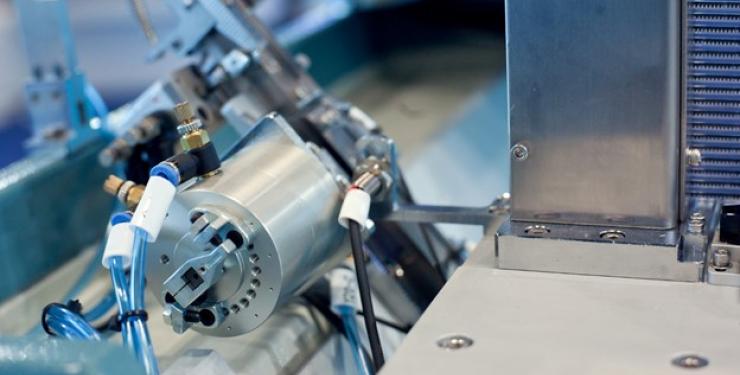What are the 5 Main Components of an Industrial Robot

Robots have become an essential element of the industrial production process, taking over repetitive, risky, and time-consuming work from people while simultaneously increasing productivity and quality. Technical breakthroughs and new inventive robots are quicker, more compact, and less expensive than earlier models. As a result, robots are now widely utilized in a variety of sectors like health care, agriculture, military, transport, and manufacturing.
Industrial robots are capable of performing human-like activities such as running, packaging, painting, welding, and carrying objects. They are designed to provide solutions to a wide range of demands and perform a wide range of functions, and so require a wide range of specialized components to complete these tasks.
In this blog article, we will review the five main components of an industrial robot.
Components of an Industrial Robot
The main components of an industrial robot are Manipulators, End Effectors, Feedback devices, Controllers, and Locomotive devices.
1. Manipulators
To simply understand what a manipulator is, think of it as the arm of a robot and like a human arm that has several joints. These joints or mechanical linkages are capable of movement in various directions to perform the work of the robot.
These mechanical linkages are driven by actuators which may be pneumatic or hydraulic cylinders, hydraulic rotary actuators, electric motors, drives, etc. The actuators may be coupled directly to the mechanical links or joints or may drive indirectly through gears, chains, or screws. When pneumatic or hydraulic drives are utilized, the flow of air or oil to the actuators is often controlled by valves mounted on the manipulator.
2. End Effectors
This is a device that is attached to the end of a robotic arm to carry out its tasks. Think of it like the palm and fingers of a human hand. The End Effector is the component that moves or orients the product or process. It is used for specialized tasks such as welding, measuring, marking, drilling, cutting, painting, cleaning, and so on.
3. Feedback Devices
These are a class of devices used to monitor an operation or process and then verify the operation or process has occurred. Back to a human body analogy, they are the organs that supply data to the brain (controller).
In a robot, a feedback device could be installed to sense the positions of the various links and joints and transmit this information to the controller. They may be simple limit switches, actuated by the robot's arm or position-measuring devices such as encoders, potentiometers, resolvers, and/or tachometers. Depending on the devices used, the feedback data is either digital or analog.
4. Controllers
The robot controller is a computer, composed of hardware and software, linked to the robot and essentially functions as its "brain”. Controllers have all of the characteristics associated with computers and contain sophisticated decision-making and data storage capabilities. They initiate and terminate the motion of the manipulator through interfaces with the manipulator's control valves and feedback devices, or perform complex arithmetic functions to control path, speed, and position, or provide two-way communications between the controller and ancillary devices.
Let’s consider a robotic spray-painting system. This particular system uses a controller, pressure transducer, and valve positioner to control the flow of liquid paint to the spray-gun end effector. Here a pressure sensing transducer generates a proportional electrical signal that is fed into a controller. The controller then compares the input signal with a reference value and produces an output signal for a voltage-to-pressure transducer. This transducer converts an electrical signal to a variable 3 - 15 psi pneumatic signal that is used to control the output valve for the spray gun. The positioner adjusts the flow rate through the paint gun by changing the control valve setting.

5. Locomotive Devices
Muscles help in the movement of the arm, fingers, and palm in humans. For the robot, the power of movement is provided by motors. pneumatic, electric, and hydraulic motors are the three most popular types of motors used in robot movement.
Knowledge of these five components provides the foundation of understanding for working with robots used in robotic manufacturing systems that are installed, programmed, and maintained by robotics technicians.
If you want to learn more about being a robotics technician or have questions about the Robotics Technician Certificate Program, please contact a Program Consultant, toll-free at 1 888-553-5333 or email us at [email protected].
Comments
The average completion time…
Submitted by iris on Fri, 10/21/2022 - 11:13
The average completion time is approximately 28- 32 weeks of part-time study. The flexible computer-based modules are designed to fit into your schedule, not ours, so you can work at your own pace to complete the program.
robotic technician
Submitted by manafa mary obiageli (not verified) on Mon, 09/16/2024 - 05:47
I want to be a robotic technician with your help
Please contact a Program…
Submitted by iris on Mon, 09/16/2024 - 13:28
Please contact a Program Consultant toll-free at 1-888-553-5333 for assistance.

Hi, my name is jatavia and I am interested in the certification program you have and was trying to get the estimated average time it would take to gain the certification?